| Tired of London? Tired of Life.
I have always followed Samuel Johnson's dictum that when a man is tired of London, he is tired of life, although one of my all-time favourite sayings about the city (sadly unfulfilled) was Jeffery Archer’s promise “not to write again” if he got elected mayor. Were I to ever compose an epigram to celebrate London (or, more likely, a T-shirt) it would be along the lines of: The parties are a pure pleasure but I’m so grateful I don’t have to live there.
As you may have gathered from my philosophical meandering, the Autumnal crime-fiction party season is upon us and kicked off in spectacular fashion in the roof-top headquarters of Penguin with its spectacular views over the Thames.

Naturally the ruder and cruder guests could notresist the opportunity to take advantage of the setting to have some glossy new publicity photographs taken, but I’m happy to report that Shots stalwarts Mike Stotter and Ayo Onatade remained totally professional and stuck to the main business of the evening, which was to congratulate Felix Francis on his tenth novel Front Runner.
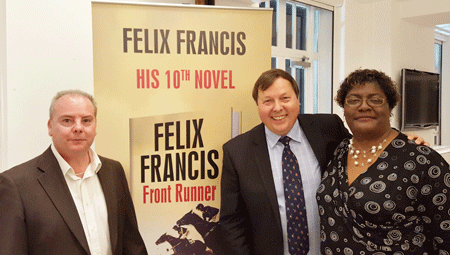
Then it was to the more refined and academic (though not necessarily more sober) environment provided by the Westminster Reference Library just off Leicester Square, tomeet Hollywood screenwriter turned Sherlockian novelist Bonnie MacBird for the launch of Art in the Blood.

Being the least knowledgeable Sherlock Holmes fan present (I suspect by a long chalk) it was an occasion for me to sit back and be amazed at the erudition and enthusiasm of Holmesian experts, for the room seemed full of them. I was reminded of the famous quote by Sir Arthur Conan Doyle who described London as “that great cesspool into which all the loungers and idlers of the Empire are irresistibly drained.” Whilst that could well have been said (and probably has) about me, it would be jolly rude to make such a sweeping generalisation about the loyal fans of his greatest creation.
Perhaps the final word on London should be left to that Victorian expert and (in the past) fine crime writer Lee Jackson who will be talking about his book Dirty Old London – The Victorian Fight Against Filth (Yale University Press) at Barts Pathology Museum on Wednesday 7th October.
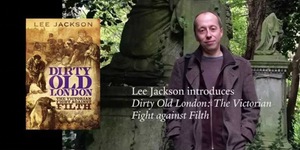
This is a ticketed event (http://www.eventbrite.co.uk/e/dirty-old-london-the-victorian-fight-against-filth-tickets-18019089582) but the ticket includes wine and the venue alone is well worth the price of admission.
Gold Rush?
It seems there is no bottom to the well when it comes to discovering forgotten ‘classics’ from the ‘Golden Age’ of British (essentially English) detective stories which have been out of print for 80 years or more.

Now the industrious Dean Street Press are reissuing four ‘Inspector Stoddart’ mysteries by that ‘lost queen of crime’ Annie Hayes (no, me neither) including The Crystal Beads Murder, her last book published in 1930 and a curiosity as Annie Hayes died before finishing it and it was completed by ‘an unknown friend and fellow writer’.
The Detective Club, a forerunner of the legendary Collins Crime Club imprint, is undergoing a revival as it continues to produce attractive (and attractively priced) new editions of some of their pre-1930 backlist, the latest being The Mystery of the Skeleton Key by Bernard Capes, which was in fact the first detective novel published by Collins back in 1919. Successful in its day, this was, I believe, the first and last detective novel by Bernard Capes, who died shortly after publication. Capes had made his name as a writer of historical novels and horror stories and, according to a delightful introduction by Hugh Lamb he was “quite fond of werewolves”.
I am particularly looking forward to Collins’ reissue, in December, of The Rasp by Philip MacDonald, originally published in 1924 and the book which introduced MacDonald’s splendid series hero Colonel Anthony Gethryn – military man, sometime secret agent, sometime newspaper columnist and (often) amateur detective.
I was unaware until recently that The Rasp had been filmed, by Michael Powell (as in ‘Powell and Pressburger’) in 1932, though the film is now believed to be lost, despite being a long-time fan of Philip MacDonald’s energetic and innovative thrillers. I regard MacDonald and Anthony Berkeley as two of the best, yet most under-rated, writers of the ‘Golden Age’ and am anxious to acquire a new copy of The Rasp as the 1941 green Penguin edition I have owned for many years is in danger of falling apart. It came originally from Hine & Son, Booksellers & Stationers of Bridport in Dorset and contains the official wartime postscript that I should: Leave this book at a Post Office when you have read it, so that men and women in the services may enjoy it too.
The leading publisher of ‘Golden Age’ mysteries at the moment, however, seems to be The British Library who have reissued a whole bookshop-full of titles in their Classic Crime series, although I have lost track of exactly what they have republished as I seem to have been dropped from their list of reviewers – perhaps for suggesting that there might just possibly be a good reason why some of these books have been out-of-print for 80 or 90 years…
I was tempted to suggest to The British Library - I have been a member for many years and am a regular researcher there - that they should also consider some of the thrillers of the ‘Golden Age’ period, as opposed to the traditional detective story. My thinking, befuddled as usual, was on the lines that the inter-war period provided Fascist Europe, Stalin’s Russia and the imperial ambitions of Japan as fertile hunting grounds for for thriller-writer and whilst the real ‘classics’ of that period (Greene, Maugham, Ambler and Household) are thankfully far from forgotten, there must surely be a reservoir of ‘neglected’ authors and titles worth rescuing from obscurity.
I am, as usual, behind the times for I read that late last month the British Library launched a Classic Thrillers imprint with titles by Victor Bridges (again, me neither) and the much better-known Sydney Horler (famous for his ‘Tiger Standish’ books and his writing once described as: ‘his characters wooden and his viewpoint Boys’ Own-patriotic’).
As I have not been allowed to see either Trouble on the Thames from 1945, or The Traitor, first published in 1936, I could not possibly comment on their quality or whether they are suitable candidates for resuscitation. Thrillers of that period are, of course, fascinating and often valuable guides for the student of history or sociology (does that still exist as an ‘ology’?) but surely very few deserve the epithet ‘Classic’ as would, say, Somerset Maugham’s Ashenden (1928), Ambler’s Epitaph for a Spy (1938) or Household’s Rogue Male (1939).
Many thrillers of the ‘Golden Age’ I know contain nuggets of economic history as well as reflecting the social values of the time, possibly even better than the more highly-regarded detective stories of the era, and to a student of the genre they are fascinating for the obvious influence they had on later thriller-writers (for example Ian Fleming’s writing was clearly influenced by the hectic thrillers of E. Philips Oppenheim and Peter Cheney). And of course some thriller writers, as well as Ambler and Geoffrey Household, who made their debuts slap-bang in the middle of the ‘Golden Age’ went on to have long and very successful careers into the 1970s and even 1980s, for example: Dennis Wheatley, Hammond Innes and Victor Canning.
So it’s an interesting area, littered with once-famous names and as I am not on the reviewing list for the British Library’s imprints, I will review what the hell I like – which is one of the benefits of great age and a column of one’s own.
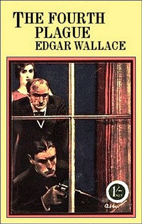 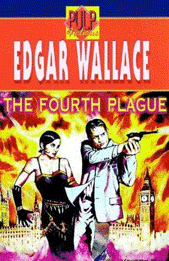
Edgar Wallace is a name which should be known to all, if only for his final creation King Kong, but in the 25 or so years before his death in 1932, he was a prolific and highly successful thriller writer, so much a legend in his own lifetime that there is a London pub named after him. I suspect, however, that few if any of his novels (it is said there were about 170 of them) would today appear on anyone’s “10 – or even 100 - Best Thrillers Ever” list.
I admit I had never heard of The Fourth Plague until I read it, having been attracted by a Prologue set in that “most equable of the cities of Tuscany”Siena, the venue for this year’s Chianti Crime Festival. Most of the novel’s action however, is set in London with a climactic shoot-out on the Essex marshes and centres on the activities of a Mafia-like ‘Red Hand’ gang of Italian criminals. It also, unusually, has an Italian detective hero operating in England as it is soon clear that Scotland Yard, the House of Commons and the British Army are incapable of dealing with the Red Hand menace without his help.
It is quite a while for the title and the nub of the plot to be explained (in terms of an early Da Vinci code!) and the writing is occasionally slapdash suggesting perhaps that the book was dictated at speed and there are some wonderfully curious phrases. An empty room is described as “innocent of furniture” and when the Italian hero disarms an assailant, the scene, which takes place in the back of an automobile, concludes with the Italian detective’s foot “pressing lightly but suggestively on his throat”.
For all that, The Fourth Plague is a rattling good read and I was surprised how tough it was considering it was originally published in 1913. Characters get shot and beaten up convincingly, adultery is accepted without moralising and there are some sharp jibes at the Home Counties squirearchy and an odious rural Magistrate in particular. Yes, it is far-fetched and occasionally silly but its pace and verve stop it falling into the ridiculous.
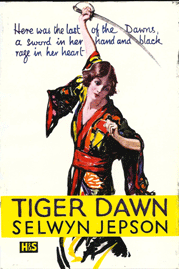 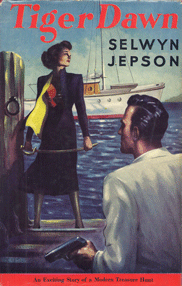
Edgar Wallace once defined the thriller as ‘a pirate story in modern dress’ and in a 1931 magazine article, Margery Allingham said much the same and cited Wallace as a prime exponent.
That definition would perfectly fit Tiger Dawn by Selwyn Jepson, first published in 1929, as it contains buried treasure, a headstrong 19-year-old heroine (the Tiger Dawn of the title), boats, fast cars, horseback riding along the Suffolk coast, sword fighting and a gang of violent Italian criminals (this time from Naples). It is strong on romance and low on suspense, the plot being propelled by a rather repetitive series of goodies-disarming-baddies and tying them up, then the baddies escaping and doing exactly the same to the goodies, who then escape and the cycle starts again. At several points, the cynical modern reader is likely to cry out for someone to just shoot someone, but despite this, Tiger Dawn has much to commend it and shows the author had a good eye for minor characters (especially fusty old solicitors) and affection for the East Anglian coastline, which is always a good sign.
Selwyn Jepson, surely a candidate for revival as much of his fiction output was during the ‘Golden Age’, is possibly better known for his service during WWII in the S.O.E. – Special Operations Executive – where he was a recruiting officer for Section F which sent Allied agents into Nazi-occupied France, many of them female and many of whom did not return.
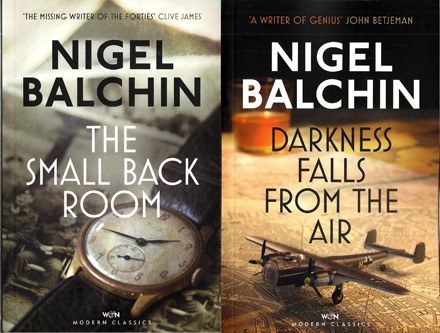
The mention of wartime experiences and publishing reissues brings me neatly on to new editions, in the Weidenfeld & Nicolson Modern Classics imprint, of the novels Darkness Falls from the Air (1942) and The Small Back Room (1943) by Nigel Balchin. The latter title, probably Balchin’s best-known work, a tense story about bomb disposal, is actually one of Lee Child’s favourite thrillers – or so he once confided to me over lunch. It was a very good lunch, so I may have misheard, but I don’t think I did.
|
|
Appreciating Ambler
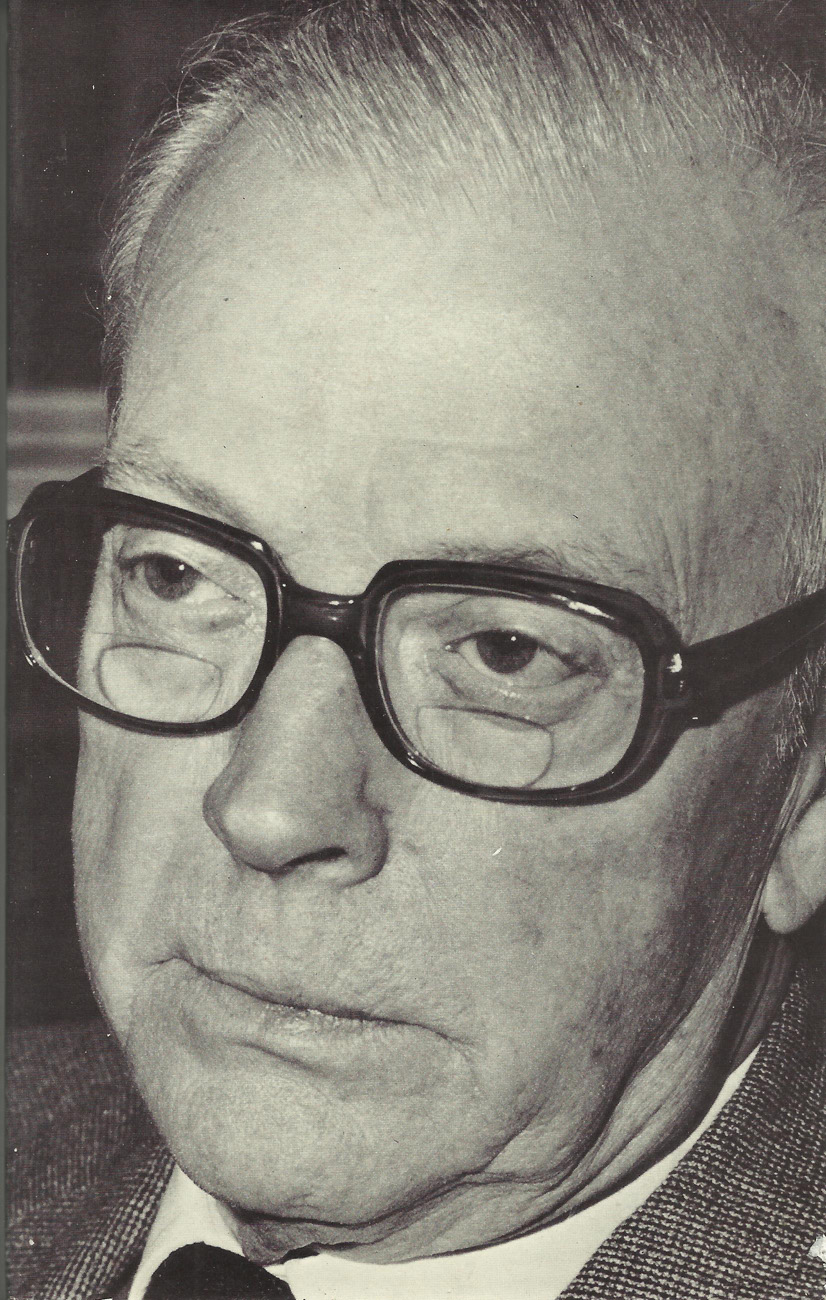 Those paying attention last month will have gathered that I am something of a fan of the work of the late Eric Ambler, and I am delighted to say I am not the only one although there was a time when I thought I perhaps was. When Ambler died in 1998, I think I am right in saying that none of his trail-blazing and highly influential thrillers were in print in the UK. This fact (I am pretty sure it was more than a rumour) provoked a small group of crime-writers to visit a well-known bookshop chain in three locations across England to demand of the staff there “anything by Eric Ambler please.” Those paying attention last month will have gathered that I am something of a fan of the work of the late Eric Ambler, and I am delighted to say I am not the only one although there was a time when I thought I perhaps was. When Ambler died in 1998, I think I am right in saying that none of his trail-blazing and highly influential thrillers were in print in the UK. This fact (I am pretty sure it was more than a rumour) provoked a small group of crime-writers to visit a well-known bookshop chain in three locations across England to demand of the staff there “anything by Eric Ambler please.”
Not only were none of Ambler’s novels available for purchase but not a single salesperson encountered during that exercise had actually heard of Eric Ambler! In recent times the situation has improved somewhat. Ambler’s books are back in print, former CWA Chairman Russell James has written a wonderful appreciation of Ambler in British Crime Writing: An Encyclopedia (sic) and Professor Barry Forshaw spoke eloquently about him at last year’s Crimefest.
In August, Professor (a real one, formerly at the LSE) John Grey spoke glowingly and intelligently on Ambler in a Radio 4 Point of View programme and I was delighted to find the text of his talk reprinted in the online BBC News Magazine at http://www.bbc.co.uk/news/magazine-33972802. I highly recommend it.
New and Pending
So much for Golden Oldies, what about the up-to-the-minute releases? Typically, the newest mystery on my to-be-read pile takes us back in time, though way beyond the ‘Golden Age’ to the 14th century to be precise.
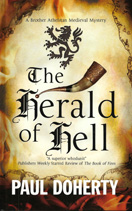
The Herald of Hell (just out from Crème de la Crime) is the fifteenth outing for Paul Doherty’s most endearing series character Brother Athelstan, a Dominican friar, the parish priest of St Erconwald’s church in Southwark (both Athelstan and Erconwald being good Anglo-Saxon names, by the way) and no stranger to a bit of detective work on the side. The year is 1381 and Athelstan is called on to investigate a suspicious ‘suicide’ in a notorious brothel called The Golden Oliphant, but London is on the eve of the ‘Great Revolt’ (or the ‘Peasants’ Revolt’ as I was taught at school, though of course I defer to Dr Doherty) and the king, Richard II, is only 14 years old. Medieval London life is about to become very unstable.
Once again, Paul Doherty uses the mystery story to give us a fascinating peek into life, law and religion in the Middle Ages, making history not only painless, but extremely entertaining.
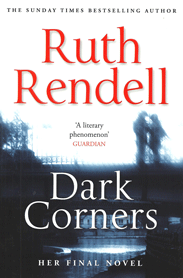
Later this month Hutchinson will publish the final novel by Ruth Rendell, who died in May. Dark Corners is a classic Rendellesque take on modern paranoia and obsession and will not disappoint her legion of bereft fans, unless that is, they are thinking of dealing in prescriptive medicines or renting property in Maida Vale; in which case it will probably scare them silly.
I was interviewed by an American magazine recently and asked what I thought was the best thing about being a crime writer. I think the expected answer involved the chance to make sense of a crazy world through fiction or establishing a connection with readers – something along those lines. Selfishly, I said it was the chance to meet one’s heroes, to get know and be in the company of supremely talented writers such as Ruth Rendell and occasionally, just occasionally, be mistaken (by association) for someone who had about a tenth of her talent.

I mention the new Penguin edition of James B. Donovan’s Strangers on a Bridge not because it is actually new (it was first published in 1964), nor because it is a stunning novel – it is actually the non-fiction account of the famous Powers/Abel ‘spy swap’ which took place in Berlin in 1962 at the height of the Cold War. It is republished now to tie in with the new Steven Spielberg film Bridge of Spies which stars Tom Hanks and Mark Rylance, which tells the same story.
Author James Donovan had close links with US Intelligence world during WWII and the reissue of his book has a Foreword by Jason Matthews, who himself had a 33-year career with the CIA. I know this because he has a book of his own coming out, also from Penguin, in January 2016.
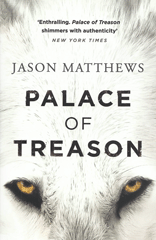
Palace of Treason, which I think is a first novel (the author having been a bit busy for the past 33 years), and has been described by the Huffington Post (so it must be true) as “The best espionage novel you’ve ever read”. Well, we’ll have to see about that. The publisher is confident enough to already bill it as The Best Thriller of 2016. We shall have to see about that too.
Next year’s Scandinavian invasion starts early, on January 1st to be precise, with a debut novel from Swedish scriptwriter Stefan Ahnhem, Victim Without A Face, published here by Head of Zeus.
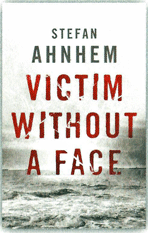
Advance publicity tells me that the book opens with “a series of gruesomely inventive killings” in the town of Helsingborg (the corporate home of IKEA) and all the victims turn out to have been in the same class of the same school and all are slain “in a way that reflects the character of the deceased”. That actually got me thinking about how my old school chum Sebastian Break-Wynd Minor, who was cursed with chronic, nay terminal, flatulence, would have been done in if Mr Sigismund, our mad Maths master, had finally cracked and gone on a Swedish killing spree.
And now a debut thriller which has already come third in a competition at the 2014 Yeovil Literary Festival, won the 2014 ‘PFD Crime Prize’ at City University, has already appeared as an eBook this year, but doesn’t actually come out as a paperback original until February next year.
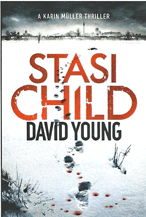
Stasi Child by David Young is one of the first titles to be published under the Bonnier Publishing Group’s Twenty 7 imprint, which I believe is reserved for first-time authors. The title should make it clear to all but those completely ignorant of European history or spy fiction, that the book is set in East Germany before the fall of the Berlin Wall. To be precise the year is 1975 and the book opens, intriguingly, with a dead female teenager whose body is found on the Eastern side of the wall, apparently after trying to escape from the West…

I am already clearing space in my 2016 Boy Scouts’ Diary for the March publication by Serpent’s Tail of She Died Young by Elizabeth Wilson, having raved about her previous novels War Damage and The Girl in Berlin. The setting for She Died Young is a twin investigation (one into possible spies, one into a murder) in Oxford and London, and the year is 1956.
Given her track record, I have no doubt that Elizabeth Wilson will once again perfectly capture the sights, sounds and smells of grey and austere post-war London. It is something at which female crime writers seem to excel. Cathi Unsworth and Aly Monroe spring to mind as contemporary examples and of course Margery Allingham did it superbly at the time.
Off-Beat
As did Pip Youngman Carter, Margery Allingham’s husband and sometime collaborator (see what I did there?), pictured here in their Essex garden in 1953.
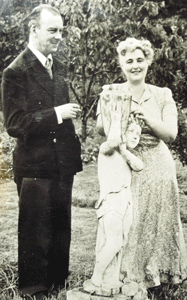
Known as an artist, journalist, wine-writer, editor, prolific designer of publishers’ dust jackets (over 2,000 of them) and paperback covers, as well as Margery Allingham’s husband for almost forty years, Youngman Carter also wrote dozens of short stories for magazines such as Argosy (UK) and the famous Ellery Queen’s Mystery Magazine.
He began writing short fiction whilst on active service in the Western Desert during WWII but his most productive period was 1959 -1962. There is evidence that around 1965 he was compiling an anthology of his stories – all with crime or mystery themes – under the title Tales on the Off-Beat but nothing came of the project. In June 1966 Margery Allingham was taken ill and died, leaving Carter to complete her unfinished novel Cargo of Eagles and then continue the adventures of his wife's famous detective Albert Campion in two more novels before he himself died in 1969.
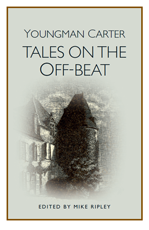
Tales on the Off-Beat, containing 25 of Youngman Carter’s stories, finally sees the publishing light of day this month, edited (I almost wrote ‘superbly edited’) by my humble self and published by Ostara in hardback, paperback and as an eBook. The stories are quirky, knowing, often sly and mischievous, atmospheric and many are distinctly spooky, generating a distinct feeling of unease. There are stories of criminals, con-men and art-dealers (he was particularly good on shady art-dealers), stories which are cheekily funny and stories definitely on the Gothic spectrum; Kane’s Doll, The Thorns Are Vicious and The Evil Eye of Brother Polidor particularly so.
Although most of these stories have not been seen for over half a century, they are well-worth revisiting (though I would say that) and no editor could have come up with a better title for this anthology than the one originally proposed by the author.
Sounds Familiar
I am informed that one of the highlights of the recent Bloody Scotland convention was a spoof panel game of improvisation called Whose Crime Is It Anyway, one of the panellists being Christopher Brookmyre.
Now Christopher is no stranger to spoof panel games ripped-off from famous radio and television shows, as twenty years ago he was a guest on one of the infamous I’m Sorry I Haven’t A Cluedo productions which were staged at crime conventions in Manchester, Harrogate and London. My archive picture shows Nicholas Blincoe and Ian Rankin (blindfolded) ‘investigating’ Denise Danks in the immensely popular “Feel the Crime Writer” round.
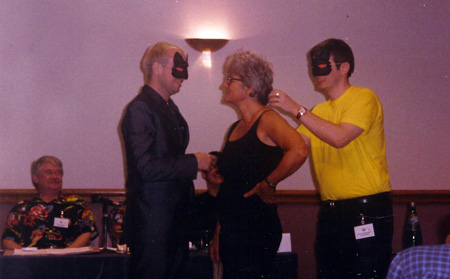
Toodles!
The Ripster.
|